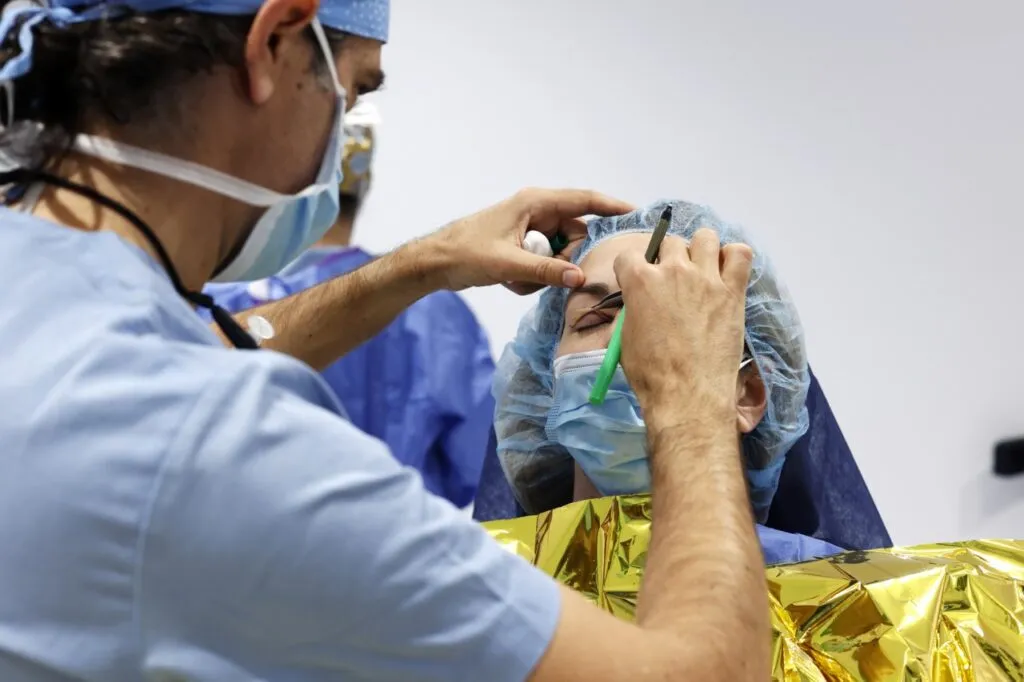
Before and after blepharoplasty
Blepharoplasty is a surgical intervention aimed at removing the excess skin or fat from the eyelids, which corrects the bags caused by ageing or inflammation and that make one’s eyes look so tired. This procedure also corrects the abnormal drooping of the upper eyelid, known as eyelid ptosis. The result, in any case, is ocular rejuvenation. However, as pointed out by doctor Alejandra Amesty, member of Vissum Grupo Miranza, “not only does it improve the patient’s appearance, but it also automatically improves their field of vision.“
When is blepharoplasty recommended?
Blepharoplasty is recommended for people with drooping eyelids that makes their eyes look sad, excess skin on the upper eyelids above the eyelashes that hinder eyesight or fatty bags below the eyes that give a tired appearance. This latter reason is the most common, because, with ageing, the skin around the eyes becomes redundant, the muscles lose tone and the fat moves forwards from the orbit. And everyone ages. This is precisely why blepharoplasty is the most common cosmetic eyelid surgery. An intervention without complications that, furthermore, leaves no scars.
Before blepharoplasty: what should be considered and preparations
Both upper and lower blepharoplasty are delicate yet relatively simple surgeries for experts, such as those working at Miranza, who have performed them endless times. Despite this, however, they require a series of preparations both before and during the surgeries to guarantee optimum results. Beforehand, the eyelids should be cleaned with cleansing wipes 48 hours before the surgery, antibiotic eyedrops should be administered as indicated by the ophthalmologist and a blood count and an ECG should be performed for the purposes of the local anaesthesia.
What does the surgery entail and how long does it take?
The surgery consists of removing any excess skin or fat through tiny incisions made in the conjunctiva or externally with an incision below the eyelashes, which leave no visible scars, because they are hidden in the folds of the eyelid or on the inside of the lower eyelid. However, thanks to the advances in technology, at the Miranza clinics we perform both blepharoplasty for the lower eyelids and blepharoplasty for the upper eyelids using laser technology. This has added benefits, such as a reduction in post-operative haematoma, less inflammation and a faster recovery process.

After the blepharoplasty surgery
Each patient is unique and has unique circumstances. This is why the ophthalmologist can recommend different types of post-operative treatments, depending on the individual. The most common of these are artificial tears, antibiotic drops, corticosteriods and anti-inflammatory medication. In some cases, when the swelling or the haematoma lead to discomfort that hinders normal activity, the specialist may also suggest the use of oral analgesics, such as paracetamol.
Post-surgery precautions and total recovery time
As well as the medical treatments, the post-operative process must include a series of temporary prohibitions to encourage recovery. The most noteworthy is that the eyes must not be exposed directly to water or soap for the first week. Furthermore, for the first month swimming in the sea and in pools must be avoided, along with the use of make-up and any physical activity. Once this period is complete, and with due medical recommendation, patients can return to complete normality.
Final evaluation of the results of the surgery
At Miranza, we follow up in detail on the results of the surgery to guarantee everything is going to plan. Moreover, in cases where it is advised, we recommend patients undergo supplementary cosmetic surgery techniques, such as an eyebrow lift, or non-surgical treatments, such as chemical peels, that increase the aesthetic results of the blepharoplasty yet further and, with it, individual well-being. Their scope and duration have led to the satisfaction of millions of people.
Do you want a much fresher look and a wider field of vision? Do you think blepharoplasty might be for you? Visit your nearest Miranza centre so that our specialists can analyse your case in detail, suggest the most appropriate treatment and settle all your doubts. We are trailblazers in both Spain and Europe in performing surgeries with no visible incisions.